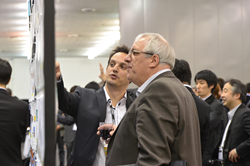Advances for Next-generation Semiconductor Processing Revealed at SPIE Advanced Lithography


BELLINGHAM, Washington, and SAN JOSE, California, USA (PRWEB) March 06, 2015
Headline-grabbing announcements of advances in next-generation semiconductor industry technologies for faster, more accurate production of smaller, more capable computer chips and devices were among many high notes heard during SPIE Advanced Lithography in San Jose last week.
Total registered attendance at the high-energy 40th-anniversary iteration of the industry’s premier annual event hit 2,320, with technical conference attendance slightly higher than last year. Dates were 22-26 February at the San Jose Convention Center. The event is sponsored by SPIE, the international society for optics and photonics.
In a highly anticipated talk, Taiwan Semiconductor Manufacturing Company (TSMC) R&D Director Anthony Yen announced that the company has achieved a milestone in recent tests on extreme ultraviolet lithography (EUVL) technology. TSMC had exposed more than 1,000 wafers in 24 hours with sustained power of over 90 Watts, Yen said.
In another session, Toshiaki Ikoma, Canon’s Chief Technology Officer and Executive Vice President, delivered a compelling case for viability of nanoimprint lithography (NIL) for high-volume semiconductor manufacturing, which is ready now for production of flash memory. Applications will soon be expanded to DRAM and eventually logic chips, Ikoma said.
Directed self-assembly (DSA) was the subject of numerous papers, with reports from imec among those describing progress toward reducing defectivity associated with the process. Working with Tokyo Electron Ltd. and Merck (which recently acquired AZ Electronic Materials), imec reported they have developed a DSA solution that is compatible with chip manufacture at the 7-nanometer process node.
In a plenary talk, University of California Berkeley professor and department chair Tsu-Jae King Liu charted the growth in the number of electronic devices from the advent of mainframe computers to 2030 when the so-called internet of things (IoT) will dominate. By then, she said, the number of devices worldwide will be in the trillions, with hundreds per person embedded in the environment and ourselves.
Low-power operation will be essential, and 3D transistors and 3D integration can provide improvements in energy efficiency and functionality that will sustain the silicon revolution.
Plenary speaker Xiaowei Shen, Director of IBM Research China, highlighted the three forces currently reshaping technology, business, and society: “Data is transforming industries, the cloud is transforming information technology, and we are engaging in new ways.”
He illustrated how the IoT could solve real-world problems, describing a 10-year IBM initiative announced last year to support China’s goals to increase renewable energy utilization, improve energy consumption efficiency, and reduce air pollution.
Alan Willner, National Photonics Initiative (NPI) steering committee member and Sample Chaired Professor of Engineering at the University of Southern California, told in his plenary talk of progress brought about through efforts of Founding Partner SPIE and others in the NPI coalition toward raising awareness among U.S. policy makers about the importance of photonics technologies.
In an update on the newly funded Integrated Photonics Institute for Manufacturing Innovation, Willner said that proposals from three coalitions are under consideration, and the chosen project will receive up to $ 110 million in matching funds.
“The vibrant networking and important announcements announced at SPIE Advanced Lithography demonstrate that the event is indeed the leading forum for the industry,” said SPIE Senior Director Andrew Brown. “The technologies inspired, developed, invented, and deployed as a result of conversations and presentations at Advanced Lithography drive the semiconductor industry, and make a sizeable contribution to the global and to regional economies. SPIE is grateful to have had a role in bringing together the people and companies enabling this progress for so many years.”
In addition to conference presentations, a 61-company exhibition connected suppliers and customers, and a professional development course program provided training in important new skills.
Ralph Dammel, CTO of AZ Electronic Materials, was presented with the 2015 SPIE Frits Zernike Award for Microlithography, recognizing his contributions to the development of photoresist, antireflective coatings, and DSA materials for semiconductor microlithography.
William Oldham and Andrew Neureuther were presented with a Special Award for Career-Long Contribution to the Art and Science of Lithography, and five new Fellows of SPIE were introduced: Luigi Capodieci, Moshe Preil, and Obert Wood of GlobalFoundries; Bernd Geh of Carl Zeiss SMT; and Masato Shibuya of Tokyo Polytechnic University.
The International Year of Light was celebrated, with displays honoring the research and technology pioneers from the Advanced Lithography community, and posters and other give-ways marking the observance.
Mircea Dusa of ASML US was symposium chair, and Bruce Smith of the Rochester Institute of Technology was symposium co-chair.
Conference proceedings are being published online in the SPIE Digital Library as manuscripts are approved, with CD and print publication to follow when all manuscripts are in.
SPIE Advanced Lithography will return to San Jose in 2016, running 21-25 February.
About SPIE
SPIE is the international society for optics and photonics, a not-for-profit organization founded in 1955 to advance light-based technologies. The Society serves nearly 256,000 constituents from approximately 155 countries, offering conferences, continuing education, books, journals, and a digital library in support of interdisciplinary information exchange, professional networking, and patent precedent. SPIE provided more than $ 3.4 million in support of education and outreach programs in 2014.